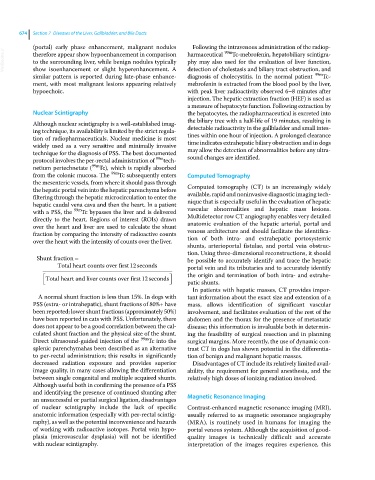Page 706 - Clinical Small Animal Internal Medicine
P. 706
674 Section 7 Diseases of the Liver, Gallbladder, and Bile Ducts
(portal) early phase enhancement, malignant nodules Following the intravenous administration of the radiop-
VetBooks.ir therefore appear show hypoenhancement in comparison harmaceutical Tc‐mebrofenin, hepatobiliary scintigra-
99m
phy may also used for the evaluation of liver function,
to the surrounding liver, while benign nodules typically
show isoenhancement or slight hyperenhancement. A
99m
diagnosis of cholecystitis. In the normal patient
similar pattern is reported during late‐phase enhance- detection of cholestasis and biliary tract obstruction, and
Tc‐
ment, with most malignant lesions appearing relatively mebrofenin is extracted from the blood pool by the liver,
hypoechoic. with peak liver radioactivity observed 6–8 minutes after
injection. The hepatic extraction fraction (HEF) is used as
a measure of hepatocyte function. Following extraction by
Nuclear Scintigraphy the hepatocytes, the radiopharmaceutical is excreted into
Although nuclear scintigraphy is a well‐established imag- the biliary tree with a half‐life of 19 minutes, resulting in
ing technique, its availability is limited by the strict regula- detectable radioactivity in the gallbladder and small intes-
tion of radiopharmaceuticals. Nuclear medicine is most tines within one hour of injection. A prolonged clearance
widely used as a very sensitive and minimally invasive time indicates extrahepatic biliary obstruction and in dogs
technique for the diagnosis of PSS. The best documented may allow the detection of abnormalities before any ultra-
protocol involves the per‐rectal administration of 99m tech- sound changes are identified.
netium pertechnetate ( 99m Tc), which is rapidly absorbed
from the colonic mucosa. The 99m Tc subsequently enters Computed Tomography
the mesenteric vessels, from where it should pass through
the hepatic portal vein into the hepatic parenchyma before Computed tomography (CT) is an increasingly widely
filtering through the hepatic microcirculation to enter the available, rapid and noninvasive diagnostic imaging tech-
hepatic caudal vena cava and then the heart. In a patient nique that is especially useful in the evaluation of hepatic
with a PSS, the 99m Tc bypasses the liver and is delivered vascular abnormalities and hepatic mass lesions.
directly to the heart. Regions of interest (ROIs) drawn Multidetector row CT angiography enables very detailed
over the heart and liver are used to calculate the shunt anatomic evaluation of the hepatic arterial, portal and
fraction by comparing the intensity of radioactive counts venous architecture and should facilitate the identifica-
over the heart with the intensity of counts over the liver. tion of both intra‐ and extrahepatic portosystemic
shunts, arterioportal fistulae, and portal vein obstruc-
tion. Using three-dimensional reconstructions, it should
Shunt fraction be possible to accurately identify and trace the hepatic
Total heart counts over first12 seconds portal vein and its tributaries and to accurately identify
the origin and termination of both intra‐ and extrahe-
Total heart and liver counts over first12 seconds
patic shunts.
In patients with hepatic masses, CT provides impor-
A normal shunt fraction is less than 15%. In dogs with tant information about the exact size and extension of a
PSS (extra‐ or intrahepatic), shunt fractions of 80%+ have mass, allows identification of significant vascular
been reported; lower shunt fractions (approximately 50%) involvement, and facilitates evaluation of the rest of the
have been reported in cats with PSS. Unfortunately, there abdomen and the thorax for the presence of metastatic
does not appear to be a good correlation between the cal- disease; this information is invaluable both in determin-
culated shunt fraction and the physical size of the shunt. ing the feasibility of surgical resection and in planning
Direct ultrasound‐guided injection of the 99m Tc into the surgical margins. More recently, the use of dynamic con-
splenic parenchymahas been described as an alternative trast CT in dogs has shown potential in the differentia-
to per‐rectal administration; this results in significantly tion of benign and malignant hepatic masses.
decreased radiation exposure and provides superior Disadvantages of CT include its relatively limited avail-
image quality, in many cases allowing the differentiation ability, the requirement for general anesthesia, and the
between single congenital and multiple acquired shunts. relatively high doses of ionizing radiation involved.
Although useful both in confirming the presence of a PSS
and identifying the presence of continued shunting after
an unsuccessful or partial surgical ligation, disadvantages Magnetic Resonance Imaging
of nuclear scintigraphy include the lack of specific Contrast‐enhanced magnetic resonance imaging (MRI),
anatomic information (especially with per‐rectal scintig- usually referred to as magnetic resonance angiography
raphy), as well as the potential inconvenience and hazards (MRA), is routinely used in humans for imaging the
of working with radioactive isotopes. Portal vein hypo- portal venous system. Although the acquisition of good‐
plasia (microvascular dysplasia) will not be identified quality images is technically difficult and accurate
with nuclear scintigraphy. interpretation of the images requires experience, this

